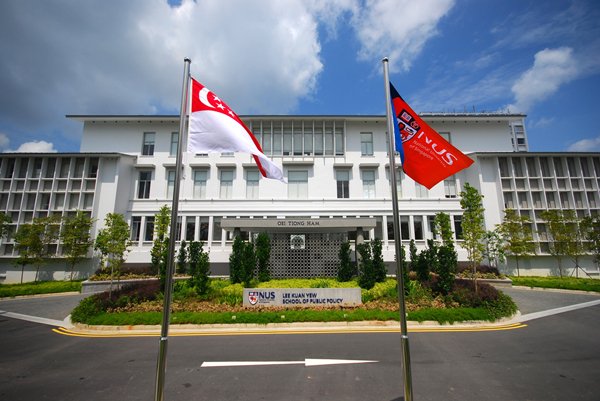Bukit Timah Campus

Students and faculty of the School enjoy a campus environment at Bukit Timah which is second to none in Singapore. Classrooms, research rooms and study spaces nestle in a parkland renowned for its beauty and serenity. The garden-like campus, with its rich variations of green from over 60 species of flowering trees and shrubs, is spread over sloping lawns and grassy quadrangles, interspersed with pristine white colonial-era architecture in the neo-classical style. Here and there, low colonial villas lay in the shade of spreading branches, half-hidden in the rise and dip of the landscape, inviting the visitor to step into a world of learning. They serve as home to think-tanks and generate strategic research on contemporary issues, from international law to Asian regional developments, from social policies to economic growth and water management.
Everywhere, student, faculty and visitor alike can claim a tranquil corner to study, reflect or day dream, or just to play a computer game and have an unhurried phone conversation. Not to mention for class discussions and more boisterous camaraderie.
The campus, shared today by the School and the National University of Singapore ( NUS )’s Law faculty, lie cheek by jowl with the sprawling world-famous Singapore Botanic Garden, with its unrivalled array of rare and splendid botany, its lakes, paths, lawns and sheltering trellis, scents, birds and flowers. Indeed, the transition from campus to Garden and back is borderless, the one merging into the other.
What sets the campus apart from the Garden are the white buildings referred to earlier. The main structures date to the third decade of the 20th century, when Raffles College, the original predecessor of NUS, was founded in 1928 as the first tertiary institution of learning for Singapore and Malaya, both then part of colonial Great Britain. In 1949, Raffles College became the University of Malaya, before being transformed, in 1962, into the University of Singapore, still housed on the Bukit Timah campus. It was only in 1986, with the burgeoning need for higher education to meet the demands of a rapidly developing Singapore, that the University of Singapore outgrew the campus and moved to its current site at Kent Ridge.
 The earliest buildings have all been wonderfully preserved, redolent of a more leisurely time with their manicured green quadrangles and cloistered corridors, inspired by older European halls of learning. They are now protected under the law as national monuments. During the later era of expansion in the 1950s and 60s, newer buildings such as the Tower Block and Block B were erected, blending seamlessly with the older buildings thanks to a similarity in architectural sobriety and simplicity. In the 21st century, all the buildings are well equipped for use as modern classrooms and lecture halls, incorporating the latest technology, easily accessible to the physically handicapped.
The earliest buildings have all been wonderfully preserved, redolent of a more leisurely time with their manicured green quadrangles and cloistered corridors, inspired by older European halls of learning. They are now protected under the law as national monuments. During the later era of expansion in the 1950s and 60s, newer buildings such as the Tower Block and Block B were erected, blending seamlessly with the older buildings thanks to a similarity in architectural sobriety and simplicity. In the 21st century, all the buildings are well equipped for use as modern classrooms and lecture halls, incorporating the latest technology, easily accessible to the physically handicapped.
Students today remain as attached and inspired as the first generations to this cradle of learning and scholarship. They partake of a living legacy, where, on a quiet late afternoon, when shadows are long, the sounds of students playing frisby in the quandrangles ring with the echoes of old ghosts who were once as young and sturdy, their future as bright with promise. Through these halls have passed students such as Singapore’s first two prime Ministers, a former Prime Minister of Malaysia, a former Vice-Chancellor of Hong Kong University, and innumerable others who went on to travel their chosen paths.
A few lines from Edwin Thumboo, an alumnus and one of Singapore’s preeminent poets, captures the ageless magic cast over all who passed through and continue to this day to stream through the campus gates :
“From my desk I watch, agreeably,
Delicate sunlight-speckled rain
Settle diamonds on each leaf.
Out of the huddled trees recurring orioles
Call sudden black and gold.
….Somnolent, wet with sound, with anagram
The years return, affirm their lore…”
Take a trip in our
virtual tour and enjoy the beautiful and scenic Bukit Timah campus.